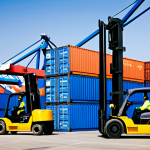Navigating the intricate world of international trade can often feel like speaking a specialized dialect, even if you’re already fluent in English. I vividly recall the sheer frustration of trying to decipher complex Incoterms or negotiate crucial contract clauses during my early days; it quickly became clear that textbook English simply wasn’t enough.
The truth is, mastering trade English isn’t just about grammar or vocabulary; it’s about understanding the subtle nuances of international law, the psychology of cross-cultural communication, and being able to articulate sophisticated concepts like blockchain-powered logistics or sustainable sourcing with absolute clarity.
In our incredibly dynamic global marketplace, where digital transformation is reshaping everything from supply chains to payment systems, the ability to communicate flawlessly in trade-specific English is more critical than ever.
Geopolitical shifts, new trade agreements, and the explosive growth of e-commerce platforms mean that what worked even a few years ago might not cut it today.
I’ve personally found that truly immersive seminars and hands-on workshops are invaluable, providing practical, real-world skills that traditional education rarely covers.
They’re where you gain the confidence to lead tough negotiations, draft ironclad agreements, and truly connect with international partners. It’s about more than just avoiding misunderstandings; it’s about seizing opportunities and staying ahead of the curve.
Let’s dive deeper into this below.
In our incredibly dynamic global marketplace, where digital transformation is reshaping everything from supply chains to payment systems, the ability to communicate flawlessly in trade-specific English is more critical than ever.
Geopolitical shifts, new trade agreements, and the explosive growth of e-commerce platforms mean that what worked even a few years ago might not cut it today.
I’ve personally found that truly immersive seminars and hands-on workshops are invaluable, providing practical, real-world skills that traditional education rarely covers.
They’re where you gain the confidence to lead tough negotiations, draft ironclad agreements, and truly connect with international partners. It’s about more than just avoiding misunderstandings; it’s about seizing opportunities and staying ahead of the curve.
Let’s dive deeper into this below.
The Nuances of Legal English in International Trade

Understanding the precise language of international trade law is less about memorizing definitions and more about grasping the profound implications of every single word.
I vividly recall one of my first major import deals where a slight misinterpretation of a seemingly innocuous clause regarding “delivery at place” nearly cost my company thousands in unexpected freight charges.
It was a wake-up call, demonstrating that dictionary meanings often diverge from their legal interpretations in trade contexts. This specific domain of English isn’t merely formal; it’s prescriptive, with each term carrying a specific weight that can shift liability, define payment terms, or dictate dispute resolution mechanisms.
Truly mastering it involves an almost forensic approach to reading contracts, agreements, and regulatory documents, searching for the hidden traps or unforeseen advantages.
It’s about being able to articulate complex concepts like force majeure, liquidated damages, or intellectual property rights with unshakeable clarity and precision, ensuring that both parties are always on the same page, or at least understand the exact parameters of their disagreements.
My personal experience has repeatedly shown that investing time in dissecting these legal texts under the guidance of seasoned trade lawyers, not just linguists, pays dividends in avoiding costly disputes and building more robust partnerships.
Decoding Incoterms: Beyond the Acronyms
When I first encountered Incoterms, they felt like an impenetrable code. FOB, CIF, EXW – it was a dizzying array of abbreviations that seemed designed to confuse.
However, as I gained more hands-on experience in shipping and logistics, I realized these aren’t just terms; they are the bedrock of who pays for what, when risk transfers, and where goods are delivered.
- The Practical Impact: My biggest “aha!” moment came during a negotiation for a large shipment of electronics. The supplier insisted on “EXW” (Ex Works), meaning all costs and risks transferred to me right at their factory gate. I initially balked, but by understanding the full implications of EXW versus, say, “DDP” (Delivered Duty Paid), I could factor in the precise costs for shipping, insurance, customs, and local delivery. It allowed me to calculate a more accurate total landed cost and negotiate a better overall deal, rather than being blindsided later.
- Avoiding Costly Mistakes: I’ve seen firsthand how a single misplaced Incoterm can lead to disputes over who pays for damaged goods or unexpected demurrage charges. It’s not just about knowing what each abbreviation stands for; it’s about understanding the practical logistics, insurance implications, and financial responsibilities tied to each one. This level of detail requires diligent study and often, real-world application to truly sink in.
Crafting Watertight Contractual Language
Drafting or even just reviewing an international trade contract demands an eagle eye and a deep understanding of contractual legal English. It’s an arena where ambiguity is the enemy and clarity is your strongest ally.
I’ve learned that vague phrasing, even if grammatically correct, can create significant loopholes.
- Precision in Definitions: Every term, especially those that define quantities, qualities, delivery timelines, or payment schedules, must be defined with absolute precision. For example, simply stating “goods will be delivered promptly” is an invitation for dispute. Instead, “goods will be delivered within 10 business days of payment confirmation, to the agreed-upon port of entry” leaves no room for misinterpretation. My personal rule of thumb is: if there’s any way it can be misinterpreted, it will be.
- Navigating Boilerplate Clauses: Force majeure, arbitration clauses, governing law – these are often considered “boilerplate,” but they are anything but. I once had a client who overlooked the governing law clause in a contract with an overseas supplier. When a dispute arose, they found themselves facing litigation in a foreign jurisdiction with vastly different legal principles, adding immense complexity and cost. I now always stress that understanding these seemingly standard clauses is critical because they dictate the framework for conflict resolution and legal recourse. It’s the boring but utterly vital stuff that protects you when things go south.
The Art of Cross-Cultural Negotiation and Communication
Negotiating in international trade isn’t just about what you say, but how you say it, and crucially, how your counterpart perceives it. My initial forays into global negotiations were humbling; I quickly realized that my direct, results-oriented American communication style didn’t always translate well in cultures that prioritized relationship-building or indirect communication.
I remember a particularly frustrating negotiation with a Japanese client where my insistence on “getting to the point” was met with polite but firm resistance.
It took me a while to understand that for them, the process of building trust and understanding was as important, if not more important, than the immediate outcome.
This experience taught me that true fluency in trade English extends beyond vocabulary and grammar to encompass a deep appreciation for the subtle cultural cues, unspoken expectations, and varied communication protocols that shape global business interactions.
It’s about learning to read between the lines, to detect enthusiasm or hesitation not just in words, but in silences, body language, and even the formality of correspondence.
Building Rapport and Trust Across Borders
The foundation of any successful international trade relationship is trust, and this is built through effective, culturally sensitive communication. I’ve learned that a genuine effort to understand and respect cultural differences can open doors that aggressive negotiation tactics might close.
- Active Listening and Empathy: My most successful negotiations have always involved far more listening than speaking. It’s not just about waiting for your turn to talk, but truly trying to understand the other party’s underlying needs, concerns, and cultural context. I remember one deal where I spent an entire initial meeting just listening to a potential partner from the Middle East discuss his family, his company’s history, and his values. Only then did we subtly shift to business, and that initial investment in rapport paid off immensely, fostering a sense of shared purpose that transcended mere commercial interest.
- Adapting Your Style: This doesn’t mean abandoning your own style, but rather adjusting it. For example, with some cultures, humor might be inappropriate; with others, direct eye contact could be seen as aggressive. I’ve often found it useful to research cultural communication norms beforehand and even consult with local contacts if possible. It’s about showing respect, which is a universal language, regardless of the words you use.
Mastering Persuasion and Diplomacy in English
Persuasion in trade English isn’t about winning arguments; it’s about finding common ground and guiding the conversation towards mutually beneficial outcomes.
It requires a delicate balance of assertiveness and diplomacy.
- Framing and Reframing: I’ve had moments where a deal seemed to hit a wall, only for it to be resurrected by reframing the issue from a different perspective. Instead of focusing on “our profit margin,” I might shift the language to “how we can jointly expand market share,” making it a shared goal. This subtle linguistic pivot can transform a competitive stance into a collaborative one.
- Handling Disagreements with Grace: Inevitably, disagreements will arise. The key is to address them professionally and respectfully, using phrases that de-escalate tension rather than inflame it. Instead of “You’re wrong,” try “I understand your point, but perhaps we could consider this alternative…” or “From our perspective, the challenge is…” This diplomatic language preserves the relationship, even when positions diverge. It’s about being firm on principles but flexible on tactics, all communicated through careful, considered English.
Navigating the Digital Frontier: Language for E-commerce and Logistics Tech
The rapid digitization of global trade has introduced an entirely new vocabulary that is essential for anyone involved in modern commerce. Just a few years ago, terms like “blockchain supply chain,” “API integration,” “EDI,” or “omnichannel fulfillment” were niche jargon.
Now, they are the everyday lexicon of efficiency and innovation. I remember the steep learning curve when my company began adopting a new cloud-based logistics platform.
Suddenly, I wasn’t just talking about shipping containers, but about “real-time cargo tracking,” “predictive analytics for route optimization,” and “smart contracts for automated customs clearance.” It was more than just new words; it was an entirely new way of thinking about the flow of goods and information.
This shift requires not only understanding these terms but being able to discuss their practical applications and implications fluently with tech providers, logistics partners, and even internal teams who might be less technologically inclined.
My personal growth in this area came from actively participating in pilot programs and digital transformation initiatives, forcing me to speak the language of innovation rather than just reading about it.
Understanding Logistics and Supply Chain Terminology
The global supply chain is a complex web, and its digital transformation has given rise to specialized terminology that’s crucial for smooth operations.
Misunderstanding these terms can lead to significant delays and costs.
- The Language of Efficiency: I’ve found that fluency in terms like “SKU,” “lead time,” “inventory management systems (IMS),” “warehouse management systems (WMS),” and “last-mile delivery” is critical for discussions with logistics providers. For example, understanding what “first-mile logistics” entails and being able to discuss optimizing it using specific technologies like IoT sensors on containers can dramatically improve efficiency and reduce transit times.
- Data and Analytics Terms: Modern supply chains are data-driven. Being able to talk about “big data analytics,” “predictive modeling,” and “supply chain visibility” isn’t just for IT professionals anymore. It’s for anyone who needs to optimize routes, forecast demand, or prevent disruptions. I recently had a conversation with a freight forwarder about using “geofencing” to monitor container movements, which was a concept alien to me a few years ago but is now becoming standard practice.
Communicating E-commerce and Digital Payment Systems
The rise of e-commerce has made understanding the technical and strategic language of online sales and digital payments indispensable. This involves both consumer-facing terms and back-end integration language.
- Online Sales Vocabulary: Discussing “conversion rates,” “customer acquisition cost (CAC),” “customer lifetime value (CLTV),” “shopping cart abandonment,” and “A/B testing” is fundamental for anyone involved in digital trade. I personally find that understanding these metrics helps in formulating effective marketing strategies and communicating with digital marketing agencies. For instance, explaining the impact of a high “bounce rate” on overall sales requires precise English.
- Digital Payment Solutions: With the proliferation of digital payment methods, terms like “payment gateway,” “merchant services,” “tokenization,” “PCI DSS compliance,” and “cryptocurrency integration” are increasingly common. I once had to explain to a client the difference between a “chargeback” and a “refund” and the implications for our payment processing fees. Navigating these discussions requires not just knowing the words but understanding the underlying financial and security processes.
Financial Acumen: Speaking the Language of Global Transactions
The flow of money is the lifeblood of international trade, and speaking the language of global finance is as crucial as understanding any other aspect of commerce.
My early experiences with international banking often left me feeling overwhelmed by a deluge of acronyms and seemingly opaque processes. SWIFT, IBAN, L/C, CAD – these weren’t just terms; they represented specific mechanisms for moving vast sums of money across borders, each with its own set of risks, costs, and compliance requirements.
I quickly realized that a superficial understanding of these concepts could lead to payment delays, unexpected fees, or even outright financial losses due to fraud or miscommunication.
It’s not enough to simply state “payment will be made.” You need to be able to articulate the specific method (e.g., “irrevocable letter of credit confirmed by a top-tier European bank”), the currency, the terms (e.g., “net 30 days from bill of lading date”), and the security protocols.
My journey into mastering this area involved poring over banking documents, attending webinars on trade finance, and not being afraid to ask my bankers “dumb questions” until I fully grasped the intricacies of international fund transfers and risk mitigation strategies.
Understanding Payment Terms and Instruments
Choosing the right payment instrument is critical for managing risk and ensuring timely transactions in international trade. Each method comes with its own unique set of advantages and disadvantages.
| Payment Instrument | Description in Trade English | Common Use Case |
|---|---|---|
| Wire Transfer (TT) | Direct electronic transfer of funds from the buyer’s bank to the seller’s bank. Often used for smaller, trusted transactions. | Advance payment, open account after established trust. |
| Letter of Credit (L/C) | A bank’s promise to pay the seller upon presentation of specified shipping documents. Reduces risk for both parties. | Large, high-value transactions; new trading relationships. |
| Documentary Collection (D/P, D/A) | Seller’s bank collects payment from buyer via buyer’s bank, with documents released upon payment (D/P) or acceptance (D/A). | Established relationships where trust is moderate, less costly than L/C. |
| Open Account | Goods are shipped and delivered before payment is due, usually on agreed-upon credit terms. High risk for seller. | Long-term, highly trusted relationships, often with strong buyer credit. |
| Consignment | Seller ships goods to buyer, but retains ownership until goods are sold to an end customer. Payment after sale. | New product introduction, market penetration strategy. |
Discussing Currency Risk and Hedging Strategies
Fluctuations in exchange rates can significantly impact profitability in international trade. Being able to discuss and mitigate currency risk is a key financial skill.
- The Impact of Exchange Rates: I recall a deal where a sudden depreciation of the local currency against the USD eroded a significant portion of my profit margin because I hadn’t properly hedged. It was a painful but valuable lesson. Now, I frequently engage in conversations about “spot rates,” “forward contracts,” “options,” and “currency swaps” to protect my earnings.
- Communicating Hedging Strategies: Whether you’re explaining a “natural hedge” (matching currency inflows and outflows) or discussing a “financial hedge” (using derivatives), clear, concise English is paramount. I’ve found that articulating the specific risks and the chosen mitigation strategies helps build confidence with partners and stakeholders, demonstrating a comprehensive understanding of the financial landscape.
Effective Documentation: Crafting Clear and Compliant Trade Papers
The paper trail in international trade is not just a formality; it’s the operational backbone, a legal safeguard, and often, a crucial component for customs clearance and financial transactions.
I remember the sheer panic when a critical shipment was held up at a port because a single document, the Certificate of Origin, had an incorrect Harmonized System (HS) code.
This seemingly minor error cascaded into days of delays, re-documentation, and unexpected storage fees. It was a vivid illustration that every line, every detail, and every piece of information on trade documents must be absolutely precise and compliant with the regulations of both the exporting and importing countries.
Mastery in this area means not just filling out forms, but understanding the purpose of each document, the critical data points required, and the specific jargon used (e.g., “consignment,” “shipper’s declaration,” “gross weight vs.
net weight”). My personal strategy has been to meticulously review every document, cross-referencing information, and educating myself on common pitfalls by studying customs regulations and best practices from trade associations.
Mastering Commercial Invoices and Packing Lists
These two documents are fundamental to every international shipment, yet errors on them are surprisingly common and can cause significant issues.
- Commercial Invoice Precision: The commercial invoice is more than just a bill; it’s a critical customs document. I’ve learned that ensuring the declared value, detailed product description (including HS codes), terms of sale (Incoterms), and buyer/seller information are accurate and match all other shipping documents is paramount. A discrepancy, even a small one, can trigger customs inspections, leading to delays and potential penalties. My advice is to treat it as a legal declaration, not just an accounting record.
- Packing List Accuracy: While less complex than an invoice, a precise packing list is vital for physical verification and smooth customs processing. I always double-check the exact count of packages, the weight (both gross and net), and the dimensions. I’ve seen situations where customs officials conduct random checks, and if the packing list doesn’t match the actual contents perfectly, it leads to extensive re-examination and holds. It’s the small details here that prevent big headaches later.
Understanding Shipping and Customs Documentation
Beyond invoices and packing lists, a myriad of other documents are required for smooth international transit and customs clearance.
- Bill of Lading/Air Waybill: These are the contracts between the shipper and the carrier, acting as a receipt for goods and a document of title. My experience tells me that understanding the difference between a “straight bill of lading” and a “negotiable bill of lading” is crucial, as it impacts who can claim the goods at the destination. Errors here can mean goods are released to the wrong party or held indefinitely.
- Certificates and Licenses: Depending on the product and destination, you might need a Certificate of Origin, health certificates, phytosanitary certificates, import licenses, or export permits. I once dealt with a shipment of organic food that required a very specific health certificate from the origin country, and its absence nearly derailed the entire transaction. Knowing which certificates are required for specific goods and countries and how to properly apply for them is a specialized but indispensable skill in trade English.
Crisis Communication: Navigating Unforeseen Challenges in Trade
Even with the most meticulous planning, international trade is inherently unpredictable. Geopolitical shifts, natural disasters, supply chain disruptions, or unexpected regulatory changes can suddenly throw well-laid plans into disarray.
When these crises hit, the ability to communicate clearly, calmly, and authoritatively in English becomes paramount. I remember vividly the frantic calls and emails during the early days of the pandemic when global logistics simply ground to a halt.
My prior experience of managing smaller disruptions taught me that in a crisis, the precise, empathetic, and factual use of language can either reassure partners and maintain trust or escalate panic and create irreconcilable rifts.
It’s about being able to articulate the problem accurately, propose solutions clearly, and manage expectations with unwavering transparency, all while under immense pressure.
This isn’t just about conveying information; it’s about leading through uncertainty and demonstrating reliability when conditions are anything but. My own strategy has always been to over-communicate, even when there’s not much to report, providing regular updates and focusing on what steps are being taken, rather than just stating the problem.
Managing Delays and Disruptions
When shipments are delayed or disrupted, timely and transparent communication is crucial to manage expectations and mitigate damage to relationships.
- Proactive Updates: My golden rule for delays is: communicate early and often. Even if you don’t have a solution, inform your partners of the issue, the likely impact, and the steps you’re taking to resolve it. Using phrases like “We are currently experiencing unforeseen delays due to [reason], but we are actively working with [party] to find a resolution” or “We anticipate a revised delivery date of [date] and will provide further updates as they become available” helps manage expectations effectively.
- Offering Solutions and Alternatives: Beyond just reporting a problem, effective crisis communication in English involves proposing viable solutions. For instance, “Given the current port congestion, we propose rerouting the shipment via [alternative port] at an additional cost of [amount], which would ensure delivery by [date]” demonstrates initiative and a commitment to problem-solving. It transforms a complaint into a collaborative challenge.
Addressing Quality Issues and Disputes
When product quality issues arise or disagreements surface, the language used can either lead to amicable resolution or protracted disputes.
- Formal and Factual Reporting: Documenting quality issues requires precise, factual language, devoid of blame or emotionality. Phrases like “Upon inspection, we observed [specific defect] affecting [quantity] units, inconsistent with the agreed-upon specifications outlined in [contract reference]” are essential. My experience has shown that providing clear evidence (photos, test reports) along with the textual description strengthens your position and facilitates resolution.
- Negotiating Resolution and Compensation: When discussing a dispute, maintaining a respectful but firm tone is key. Language such as “To resolve this matter amicably, we propose [solution, e.g., a partial credit or replacement shipment] and request your confirmation by [date]” focuses on resolution. I always aim for constructive dialogue, even when frustrations run high, using phrases that invite collaboration rather than confrontation, thereby protecting long-term business relationships.
Closing Thoughts
As we’ve explored, truly mastering English for international trade is about far more than just language proficiency; it’s about an integrated understanding of law, finance, logistics, and global cultural nuances. It’s an ongoing journey of learning, adapting, and growing, much like the ever-evolving global marketplace itself. I’ve personally found that the more I invest in refining these communication skills, the more resilient my partnerships become, and the more opportunities I uncover. This isn’t just about avoiding missteps; it’s about confidently seizing every chance to expand your reach and secure your standing in the intricate world of global commerce.
Useful Information
1.
Engage with global trade associations like the International Chamber of Commerce (ICC) or your local World Trade Centers. Their workshops and publications offer invaluable, practical insights into evolving trade practices and legal frameworks.
2.
Consider advanced certifications such as the Certified Global Business Professional (CGBP) or specialized courses in Legal English for International Trade. These programs often provide scenario-based learning that hones your practical application skills.
3.
Regularly read reputable trade publications like The Journal of Commerce, World Trade Magazine, or official customs agency websites. Staying current on regulatory changes and market trends is as crucial as understanding the language itself.
4.
Practice mock negotiations and contract reviews. Role-playing with peers or mentors, using real-world case studies, can expose you to nuanced situations and force you to articulate complex ideas under pressure.
5.
Build a global network. Connect with professionals from diverse backgrounds on platforms like LinkedIn or at international trade fairs. Real-life interactions provide context, cultural understanding, and practical language exposure that textbooks simply can’t.
Key Takeaways
Mastering English for international trade isn’t just about vocabulary; it’s about navigating complex legal, financial, and cultural landscapes. Precision in contracts and Incoterms is paramount, alongside the diplomatic art of cross-cultural negotiation. Fluency in digital logistics and e-commerce terminology is non-negotiable in today’s market, as is a firm grasp of international payment systems and currency risks. Finally, impeccable documentation and calm, clear crisis communication are your shields against unforeseen challenges, ensuring trust and smooth operations.
Frequently Asked Questions (FAQ) 📖
Q: Why is “textbook English” often insufficient for navigating the complexities of international trade, even if you’re already fluent?
A: Oh, I’ve lived this frustration! You see, textbook English gets you by in general conversation, but international trade… that’s a whole different beast.
It’s like being fluent in everyday English but suddenly needing to understand highly specific legal jargon, nuanced cultural communication styles, and the unwritten rules of negotiation that differ wildly from one continent to another.
I vividly recall a time I thought I had a contract clause nailed down, only to realize my “fluent” understanding completely missed the subtle implication of a specific Incoterm.
It wasn’t about vocabulary; it was about the context, the legal weight, and the business psychology behind the words. You need to speak a dialect of English that is precise, legally sound, and culturally intelligent, not just grammatically correct.
Q: What are the biggest challenges or new demands making the ability to communicate flawlessly in trade-specific English more critical today?
A: Honestly, it feels like the ground beneath us is constantly shifting! When I first started, digital transformation was a buzzword, not the seismic shift we’re seeing now.
Today, you’re not just discussing prices; you’re articulating concepts like blockchain traceability in a supply chain, the intricacies of AI-driven logistics, or the ethical nuances of sustainable sourcing with global partners.
Geopolitical shifts, like new trade agreements or unexpected tariffs, can turn your existing contracts upside down overnight, demanding immediate, clear communication.
And don’t even get me started on the explosive growth of e-commerce – suddenly, a small business in the Midwest is dealing with customers or suppliers across the globe, needing to be just as sharp in their trade English as a multinational corporation.
The old ways of “doing business” simply aren’t enough to keep pace; it’s about staying agile and articulate.
Q: What’s the most effective way to truly master trade English and gain practical skills, beyond traditional education?
A: From my own journey, the answer is hands-on immersion, without a doubt. Traditional education gave me the basics, but it was those deep-dive seminars and workshops that truly transformed my capabilities.
I remember thinking, “Finally, this is real!” We weren’t just memorizing terms; we were running mock negotiations, drafting complex agreements with real-world scenarios, and dissecting case studies where a single word choice made or broke a deal.
It’s in those environments where you practice articulating sophisticated concepts, where you learn to read between the lines of a cross-cultural email, and where you gain the confidence to lead a tough conversation with a partner from a completely different legal or business background.
It’s not just about learning words; it’s about building the muscle memory for effective, precise, and persuasive communication in the high-stakes arena of international trade.
📚 References
Wikipedia Encyclopedia
구글 검색 결과
구글 검색 결과
구글 검색 결과
구글 검색 결과
구글 검색 결과






